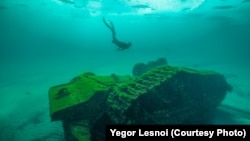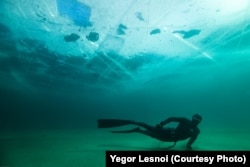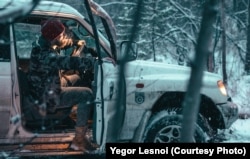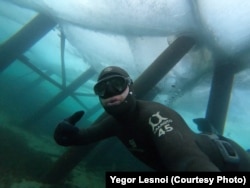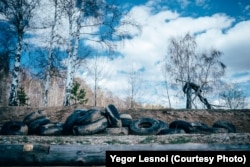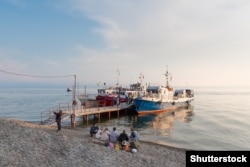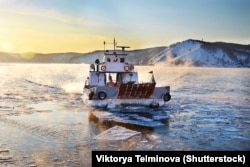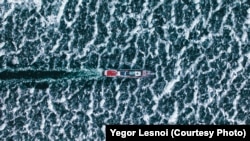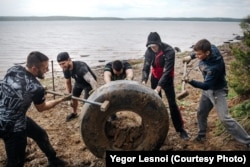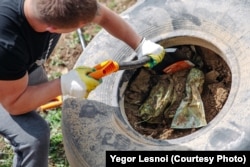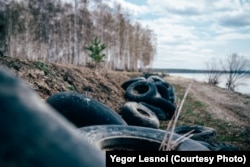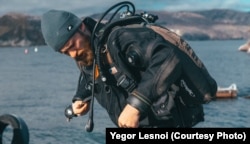Yegor Lesnoi is cleaning up the bottom of Lake Baikal for the third year in a row, and does so in his spare time and absolutely for free. He makes money by making advertisements and documentaries.
Lesnoi usually dives alone, with a friend waiting for him on a jet ski. For several years now they have developed an effective scheme for lifting tires out of deep water.
"Generally, I am an opponent of big teams. You don't need a lot of people to pick up trash. On the contrary, it is even more difficult to organize a crowd than a couple of people. I always say -- you just need to go and clean up the trash by yourself. There is no need to go far if you have no car, there will always be something to clean up within the city limits," Lesnoi says.
On the other hand, he drives 70 kilometers from Irkutsk to Listvyanka in order to drag tires from the bottom of Lake Baikal.
"I have been diving there for many years, so when I got preoccupied with the problem of garbage, I started underwater cleaning from Listvyanka. This year I came to the conclusion that cleaning as a pair is the best option: I attach a cable to the tire at the bottom, my partner on a jet ski waits at the top, then he drags the tire to the shore. The thing is that the tires are usually almost completely grown into the silt."
"I used to pull tires out of the silt with my hands, which was incredibly difficult, especially considering that I am holding my breath underwater. I dive without diving tanks. It is good to use such equipment when you need to dive for a long time in depth and collect small rubbish in a bag. But with huge tires you need to dive a lot and often, to talk quickly with the driver of the jet ski, so it's better to hold your breath. When a jet ski tears the tire out of the silt and carries it through the water with speed, the tire is simultaneously cleared of sand, silt, and algae and reaches the shore already clean."
Yegor says that after collecting the tires, they take them to the Irkutsk rubber-processing plant: "At first, we just took everything to recycling, but last year I had an idea to make a safe surface for a sports ground or playground in the village of Listvyanka," he says.
"There are many hotels, cafes, a tourist market, an observation deck, and even a ski slope, but not a single sports ground or playground for kids. There are two very old ones, they are in very bad condition. And we want to make a professional one, on the shore of Lake Baikal, from where we pulled out the tires. It will definitely be an iconic place."
"When I proposed this idea to the guys from the rubber-processing plant, they immediately agreed to cooperate. I got some money from private foundations and interested people. In general, one such sports ground requires 15 tons of tires. In the first month, the two of us collected from the bottom of Baikal a total of 4.5 tons."
"The amount differs from time to time: for example, yesterday we lifted about 200 kilograms of tires, and before that about 1,200 kilograms. Some tires weigh 120-130 kilograms. Three of them make almost half a ton. But we would definitely need to dive dozens more times."
Lesoi says upcoming cold weather won't stop them from reaching their goal: "We also dive in winter, we don't care about the weather and temperature. We do not set a specific deadline, but we are trying to reach our goal as soon as possible, of course."
"We developed a project with the help of the rubber-processing plant and offered it to the foundations. They will buy sports equipment directly, reconstruct the area, buy glue for the surface. The crumb rubber itself makes up only 50 percent of the coverage, the rest is a special German polymer glue, which is quite expensive. It retains the elastic properties of rubber, but at the same time blocks decomposition and release of harmful substances, because tires are hazardous waste," Lesnoi says.
"And on the playground it should be an absolutely safe cover. There are unscrupulous manufacturers of such surfaces who buy cheap bonding adhesives. They do not block the decomposition of the rubber-crumb residues. In such cases people complain that in the summer heat the site stinks so much it is impossible to approach it. This needs to be carefully monitored."
The source of such pollution in the water is not obvious at first glance.
"The tires do not come from cars, and it is not people throwing them into the water. They are used on ships and berths. They are bolted to the sides of the ships in order to absorb the impact of berthing. And sometimes they fall off," Lesnoi explains.
"These ship fenders are outdated and unecological, but they are still used here. Navigation has existed on Lake Baikal for a long time and no one has ever cared about these tires. In some places on the lake, huge amounts of tires have accumulated."
"And the amount [of tires] just keeps on growing. We have been diving at Rogatka pier in Listvyanka for three years and every six months we pull up an average of 200-300 kilograms of tires from there. Every season we clean it almost clean, and by the next season they reappear," Lesnoi says.
Lesnoi says they are fighting the result, not the cause of the problem: "There is no legal prohibition on the use of tires as ship fenders. Although there are eco-friendly alternatives, and quite inexpensive, even taking into account the Finnish production. The Finns make hollow fenders out of elastic PVC that do not sink. They cost from 2,500 to 5,000 rubles [$35-$70], depending on the size.
"However, the entire commercial fleet in Russia uses destructive tires. This is mainly the old fleet left over from the Soviet times, bought up by private traders. There should be a law that obliges them to use safe fenders."
"We began to communicate with the regional officials, who will be able to promote it on the federal level. They supported us in words, but that's all for now. Today, all of our meetings with state officials end with bureaucratic red tape -- papers, reports. So we prefer to just get in the car, and go and do it," he says.
Before cleaning tires out of Baikal, Lesnoi was known for other envirnmental projects, such as cleaning the marble quarry in Buguldeika, or cleaning the banks of the Irkutsk reservoir, which is located on the Angara River, which drains Lake Baikal.
"It was strategically important to clean the shore of the reservoir," Lesnoi says. "About 100 tons of tires were removed from it. Moreover, these tires were clogged with soil, which had to be knocked out -- each one took approximately 40 minutes."
Lesnoi says there are many tourists coming to Lake Baikal despite the pollution. "There is no problem with tourists, they come to Baikal in large numbers," he says. "I just think that the infrastructure should be more modern. And I can understand that the management of the nature reserve does not have enough resources for it."
In the summer of 2020 Lesnoi was charged for participating in an uncoordinated rally in which more than a thousand Irkutsk residents protested against the amendments to the constitution and against the new law allowing deforestation near Lake Baikal. At the protest Lesnoi carried a poster saying, "Volodya [Putin], cut down yourself, not our forest!"
A little less than a year later, Lesnoi was sentenced to 80 hours of community service. Lesnoi himself noted that such a sentence does not change anything in his life, since he will do what he was doing before -- clean up garbage for free.
Lesnoi says that he was lucky with such a sentence, as it could have been much worse. "I was lucky, because I was stationed to work in Listvyanka, and I was doing all the same work as before the verdict, collecting garbage."
He says he does not regret participating in the rally, but also mentions that things have changed a lot in the past year. At the moment his plans are to wait and not fight hard against the situation, "but it is difficult," he says.
"I am changing people's attitude towards the environment. I will achieve my goal anyway. At the same time, I will get tremendous experience, which, perhaps, will become very necessary in the future. But so far it is difficult to implement everything on a large scale."




